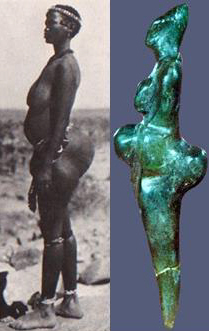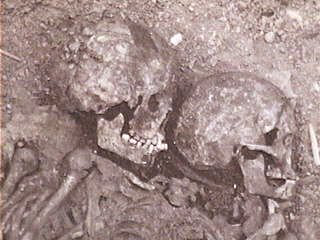The Grimaldi was a nation of Black Afrikans who were the first modern humans to leave the vast tribal Afrikan lands for the moist, cold shores of Europe. Their eminence was deliberately hidden by the unusual classifications used to label them, such as Neolithic men, Grimaldi, and so on. This group of Afrikans discovered the European continent some 40,000 years ago.
Over many centuries they travelled from the Cape of South Afrika to Spain, Italy and France, as at that time it was possible to walk on dry land since the Straits of Gibraltar was not yet in existence. Many of these Afrikans stopped along the way to settle and develop nations, and after reaching Europe, the Grimaldi spread all the way through Switzerland, Illyria, Bulgaria, Southern Europe and Brittany which is today's England, Wales and Scotland.
It is now easy to forget that the people who presently inhabit those countries like America, Australia, Europe and Spain are not indigenous to these places. Their ancestors were either once immigrants or part of the invading armies and tribes that committed hundreds of abominable atrocities against the native people. Moreover, the world needs to be reminded that the borders of Afrika ended on the Pyrenees, and the Iberian Peninsula was at one time physically joined to North Africa which, from the earliest times of antiquity, featured positively in Afrikan history.
Black Africans were therefore the aborigines who first settled Spain and lived there for thousands of years prior to the 1492 conquest of Granada by the rebellious armies of Ferdinand of Aragon and Isabelle of Castile. Black Afrikans were therefore the first Europeans who made their home in Greece and established the Greek civilization which later became Europe's classical civilization. These Afrikans were the ones responsible for enlightening Greece when they became the political power in Egypt and not the other way around. When Europe had lapsed into the Dark Ages again, it was mainly because of the guidance of the Black Afrikan Moors who entered Europe and established universities in Spain and Portugal, that Europe was able to re-emerge from that darkness.

 When Homo sapiens sapiens appeared for the first time in Europe some 40,000 years ago, they resembled the green figure (on the right) which is a Grimaldi statue, used to compare with a Zulu woman (to its left), who has the same basic body structure with heavy fatty deposits in the rear which is technically known as steatopygia (which is an accumulation of large amounts of fat on the buttocks, especially as a normal condition in the Khoikhoi and other peoples of arid parts of southern Africa). This body type is most prominent in both Zulu and pigmy populations, (left) but here it is also found in the Grimaldi Negro populations. At this point the European population was a Black Afrikan population, a fact that was verified from several bones excavated. In other words, the palaeontology's study of Grimaldi bones in Europe dating back to 40,000 years clearly shows them to be Afrikan in origin and anatomy.
When Homo sapiens sapiens appeared for the first time in Europe some 40,000 years ago, they resembled the green figure (on the right) which is a Grimaldi statue, used to compare with a Zulu woman (to its left), who has the same basic body structure with heavy fatty deposits in the rear which is technically known as steatopygia (which is an accumulation of large amounts of fat on the buttocks, especially as a normal condition in the Khoikhoi and other peoples of arid parts of southern Africa). This body type is most prominent in both Zulu and pigmy populations, (left) but here it is also found in the Grimaldi Negro populations. At this point the European population was a Black Afrikan population, a fact that was verified from several bones excavated. In other words, the palaeontology's study of Grimaldi bones in Europe dating back to 40,000 years clearly shows them to be Afrikan in origin and anatomy.
 The opening of Grimaldi graves in addition to other excavations on the European continent, have unearthed skeletons and artefacts in layers far beneath those of the Cro-Magnons which provided more than enough evidence to show that the Grimaldi were its earliest inhabitants. So just by using the body type alone it is clear that a Black Afrikan population was the original European population. Archaeological and genetic evidence also show that the Grimaldi were Negros of the Central and West Afrikan grouping, with facial and head characteristics paralleling those of the San tribe or Bushmen of South Afrika.
The opening of Grimaldi graves in addition to other excavations on the European continent, have unearthed skeletons and artefacts in layers far beneath those of the Cro-Magnons which provided more than enough evidence to show that the Grimaldi were its earliest inhabitants. So just by using the body type alone it is clear that a Black Afrikan population was the original European population. Archaeological and genetic evidence also show that the Grimaldi were Negros of the Central and West Afrikan grouping, with facial and head characteristics paralleling those of the San tribe or Bushmen of South Afrika.
The features of the Grimaldi consisted of the typical large, flat noses with facial and head characteristics resembling the Koramus people of South Afrika and the Bushmen who arrived thousands of years later. The Grimaldi adorned themselves with elaborate hair styles that resemble today’s corn rows and the peppercorn hair style, which still bear resemblance to those of today’s Blacks in West Africa, the Caribbean and the United States.
The Grimaldi Negroes left evidence of their culture with items such as stone implements and other useful tools for working in the environment, communication symbols, musical instruments, and the first bow and arrow that enabled the thousands of generations of Barbaric Europeans to survive down through prehistory times until the beginning of the Roman period.
 During the later Palaeolithic period, the Grimaldi were the most powerful and influential force on the continent. These Blacks were accomplished and cultured, having brought the arts and survival skills with them that gave new life to the decayed and stagnant Neanderthal European period. They contributed greatly to the early or first arts of Europe as confirmed through the statuettes unearthed by archaeologists, which display astounding workmanship. They were the oldest sculptures created by man; in fact, the statue of The Maid of Willendorf found in Austria (right), is recognised as "the first signs of art on earth".
During the later Palaeolithic period, the Grimaldi were the most powerful and influential force on the continent. These Blacks were accomplished and cultured, having brought the arts and survival skills with them that gave new life to the decayed and stagnant Neanderthal European period. They contributed greatly to the early or first arts of Europe as confirmed through the statuettes unearthed by archaeologists, which display astounding workmanship. They were the oldest sculptures created by man; in fact, the statue of The Maid of Willendorf found in Austria (right), is recognised as "the first signs of art on earth".
These important discoveries also show the scope of their migration when taking into account that pieces of Grimaldi sculpture were also found in southern Siberia and Russia, yet the touring exhibits of Ice Age Art from Europe deliberately exclude any mention of this Grimaldi art.
The Grimaldi disappeared around 12,000 B.C. One reason offered for this disappearance was that the Cro-Magnons eliminated them. Another claim suggests that the mixing of the races caused the Grimaldi Blackness to become absorbed and lost, while another argument indicates that they migrated to other parts of the world, mixed with other people there, and established other nations.

© John Moore - Barbados, W.I. (March 2000) ©. All rights reserved.